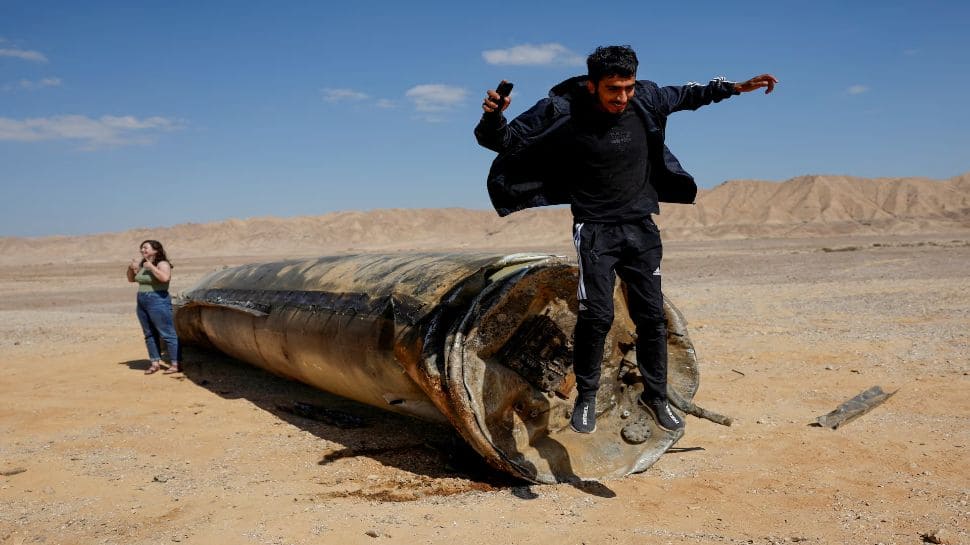Washington: The night of April 13, 2024, marked a turning point in decades of tension between Israel and Iran. Earlier that April, Israel had struck the Iranian commercial embassy in Damascus, killing senior officers of the Revolutionary Guards. Tehran described that assault as a violation of its sovereignty and vowed retaliation. On April 13, Iranian drones and missiles struck Israeli targets under Operation True Promise, signalling strength rather than intending civilian casualties.
Some Iranian missiles hit their targets, but militarily the operation achieved limited success. Israeli air defense systems played a crucial role, but American pilots were equally pivotal. U.S. Central Command confirmed that more than 80 Iranian drones and six ballistic missiles were destroyed that night.
The U.S. Air Force released a documentary on YouTube titled ‘Dangerous Game’, presenting the events through the eyes of F-15E Strike Eagle pilots. The 36-minute film captures the tactical, psychological and operational challenges American forces faced that night.
Tower 22 And Rising Tensions
To grasp the significance of the April attack, earlier events must be recalled. On October 7, 2023, Hamas attacked Israel, triggering conflict in Gaza. Hezbollah simultaneously launched attacks in northern Israel, while Yemeni Houthis fired missiles from the south.
On April 1, 2024, the Israeli strike on the Iranian embassy in Damascus killed senior Revolutionary Guard officers, including Mohammad Reza Zahedi, prompting Iran to promise a strong response. Earlier, in January 2024, a drone strike on Jordan’s ‘Tower 22’ killed three American service members.
Major Benjamin of the 494th Fighter Squadron said, “After the Tower 22 attack, everything became personal. The deaths of American soldiers were a huge shock. We knew we would be called to protect our comrades soon.”
Shahid-136 Drones: A New Challenge
The Shahid-136 drones played a central role in Iran’s attack. They were inexpensive, flew at low altitudes and could reach speeds of up to 180 km/h.
Former Marine Alex Hollings explained, “The biggest advantage of Shahid drones is that they are cheap and produced in large numbers. They can bypass enemy defenses and their slow speed makes them a problem.”
He added that these drones were designed to evade radar and strike targets with precision.
A captain described using ground-based targetting pods to detect Iranian drones. This unusual technique proved highly effective. Pilots minimised radio chatter to stay focused, repeating a single phrase multiple times: “Drone there.”
From Normal Night To Focus Three
The documentary begins with a silent night at an unnamed base. Shifts changed, reports were exchanged and fighter jets stood ready. Hours later, pilots would face the largest engagement of their careers.
Calls for Line One and Line Two summoned pilots to emergency readiness. Major Benjamin said, “The danger we imagined was only 10-20% of the actual threat.”
F-15s launched into the dark, and radar screens flooded with Iranian drones. Missile launch orders were issued, and the declaration of ‘Focus Three’ signalled that firing radar was active.
Benjamin recalled firing an AIM-120 AMRAAM missile for the first time in actual combat. Another pilot described flying at just 1,000 feet while the safe altitude was 4,000 feet. Teams attempted to strike drones with laser-guided bombs, initially believing their attacks were successful, only to see the drones remain operational moments later.
Missile Count And Red Alert
As pilots prepared to refuel, Iranian ballistic missiles illuminated the eastern sky. One pilot said, “I could only count up to 13 before the missiles became impossible to track.”
Some of the missiles were intercepted midair, with their debris raining down below, while others managed to hit their targets.
A red alert was issued at the base. Flight Commander ‘Voodoo’ instructed, “Red alert means arm the aircraft, cover the planes and then move to safety.”
Pilots described the tension as a Formula One race, with refuelling, missile loading and engine checks completed in only 32 minutes. Normally, refuelling alone requires this much time.
Returning under fire, pilots faced minimal guidance. One recalled, “I was ready for the attack, but not for landing at a low-fuel base under threat.”
Once the danger subsided, pilots checked their phones to see messages from loved ones as media headlines declared Iran had launched its largest missile and drone attack on Israel.
In the final moments of ‘Dangerous Game’, a pilot said, “Out of the eight missiles we had, only one remained, which could not be fired due to a technical fault. It was not our mistake.”

